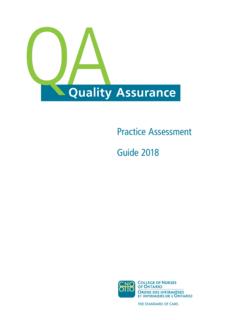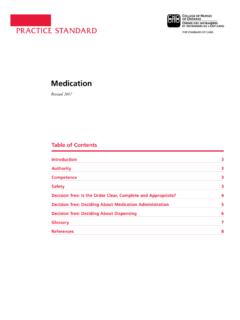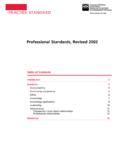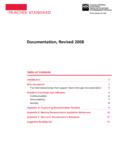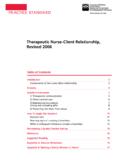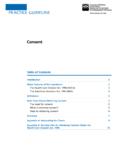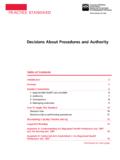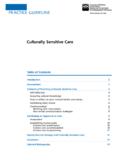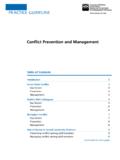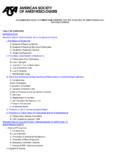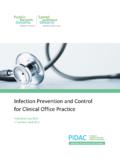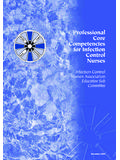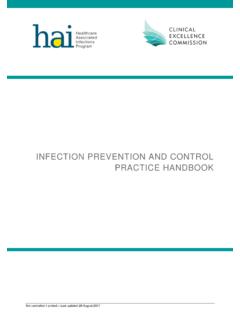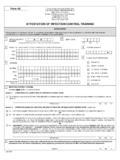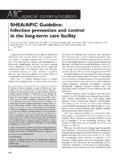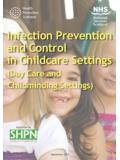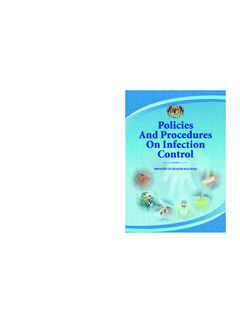Transcription of PRACTICE STAndARd - CNO
1 PR ACTICE STAndARdTable of Contents Introduction 3 STAndARd Statements 4 Application of evidence-based measures 4 Application of professional judgment 4 Risk reduction 5 Communication 5 Maintaining a Quality PRACTICE Setting 6 Case Scenarios 8 Appendix 9 Glossary of Clinical Terms 11 References 12 Infection Prevention and ControlInfection Prevention and control Pub. No. 41002 ISBN 1-897074-32-8 Copyright College of Nurses of Ontario, or for-profit redistribution of this document in part or in whole is prohibited except with the written consent of CNO. This document may be reproduced in part or in whole for personal or educational use without permission, provided that: Due diligence is exercised in ensuring the accuracy of the materials reproduced; CNO is identified as the source; and The reproduction is not represented as an official version of the materials reproduced, nor as having been made in affiliation with, or with the endorsement of, published February 1996 as Infection control Guidelines (ISBN 1-894557-33-6)Reprinted January 2000, October 2000, revised for Web June 2003, reprinted January 2004 as Infection control (ISBN 1-894557-44-1)Revised June 2004, December 2005.
2 Reprinted May 2008 (ISBN 1-897074-32-8). Updated in June copies of this document may be obtained by contacting CNO s Customer Service Centre at 416 928-0900 or toll-free in Ontario at 1 800 of Nurses of Ontario 101 Davenport Rd. Toronto, ON M5R fascicule existe en fran ais sous le titre : La pr vention des infections , n 51002 OuR MISSIOn is to protect the public s right to quality nursing services by providing leadership to the nursing profession in vISIOn is excellence in nursing PRACTICE everywhere in ACTICE S TAndARd3 College of Nurses of Ontario PRACTICE STAndARd : Infection Prevention and ControlNursing standards are expectations that contribute to public protection. They inform nurses of their accountabilities and the public of what to expect of nurses.
3 standards apply to all nurses regardless of their role, job description or area of PRACTICE . College of Nurses of OntarioIntroductionEnsuring the use of safe, effective and ethical infection prevention and control measures is an important component of nursing care. This PRACTICE STAndARd is evidence-based and outlines PRACTICE expectations for all nurses1 in all roles and PRACTICE settings. A PRACTICE STAndARd is an authoritative statement from the College of Nurses of Ontario (the College) that sets out the professional basis of nursing PRACTICE . All standards provide a guide to the knowledge, skills, judgment and attitudes that are needed to practise safely. They describe what each nurse is accountable and responsible for in PRACTICE . Nurses are expected to be aware of College standards and relevant governmental directives concerning infection prevention and control practices .
4 Public protection is achieved when nurses practise according to the of clinical infection control practices is continually growing and changing. While the principles of infection control (prevention, transmission and control ) do not change, specific clinical practices may evolve as a result of new evidence. For this reason, this PRACTICE STAndARd provides broad statements and does not include specific clinical PRACTICE information. A nurse is expected to consult appropriate resources for clinical advice and access resources in a timely manner. These resources may include, but are not limited to, an infection control practitioner, relevant nursing resources and guidelines from Health Canada and the Ministry of Health and Long-Term Care. All nurses, in all roles and settings, can demonstrate leadership in infection prevention and control by using their knowledge, skill and judgment to initiate appropriate and immediate infection control procedures.
5 This PRACTICE STAndARd describes a nurse s role in infection prevention and control . There are six sections: STAndARd statements and indicators that outline the basic expectations for nurses, a review of quality PRACTICE settings, case scenarios that illustrate how the standards can be applied, an appendix on infection transmission and management, a glossary of clinical terms and a reference What is the simplest and most important PRACTICE a nurse can do to reduce contamination and spread of infection? A. Proper hand hygiene is the single most-important infection prevention and control In this document, nurse refers to a Registered Practical Nurse (RPN), Registered Nurse (RN) and Nurse Practitioner (NP).PR ACTICE S TAndARd4 College of Nurses of Ontario PRACTICE STAndARd : Infection Prevention and ControlIndicatorsThe nurse meets the STAndARd by: assessing situations for potential or actual infectious disease transmission; selecting and using the appropriate prevention measures when micro-organisms are likely to come into contact with the nurse s skin, mucous membranes or clothing; modifying her/his PRACTICE appropriately when there is a risk of transmitting a disease to clients or other health care providers; selecting, in collaboration with the health care team, the appropriate agency, manufacturer and government guidelines regarding the use and fit of personal protective equipment (PPE).
6 And advocating for change when agency, manufacturer or government guidelines do not meet infection control requirements regarding the appropriate use and fit of of professional judgment Nurses exercise professional judgment relevant to each client situation and infection prevention and control nurse meets the STAndARd by: adhering to appropriate hand hygiene protocols; using a systematic approach to care (for example, nursing process) based on current infection control principles and research; knowing her/his personal immunization status relevant to the PRACTICE setting and taking appropriate action to ensure client protection; knowing a client s immunization status relevant to the PRACTICE setting and taking appropriate action to ensure protection of clients, others and self (for example, information, referral, isolation, etc.)
7 ; taking all measures necessary to prevent the transmission of infection from the nurse to client(s) or other health care providers; seeking advice from her/his primary health care provider regarding the potential for transmission to clients or other health care providers when the nurse has a potentially transmissible disease; maintaining competence in infection control practices by accessing appropriate resources (for example, infection control practitioners, current research); taking appropriate action when a co-worker has a potentially transmissible disease; advocating for an environment and equipment that reduce the risk for disease transmission; and advocating for the establishment of and compliance with infection control policies relevant to the PRACTICE StatementsApplication of evidence-based measures Nurses understand and apply evidence-based measures to prevent and control transmission of micro-organisms that are likely to cause ACTICE S TAndARd5 College of Nurses of Ontario PRACTICE STAndARd : Infection Prevention and ControlIndicatorsThe nurse meets the STAndARd by: incorporating the psychosocial needs of clients and their significant others into the plan of care; using appropriate teaching strategies to communicate health information to clients.
8 Developing creative or innovative communication strategies to overcome factors that could inhibit the therapeutic nurse-client relationship (for example, isolation, masks); maintaining open communication with the health care team, including support staff; communicating safety concerns to the appropriate authority; and advocating for communication systems that protect client Nurses use appropriate and timely communication strategies with clients and their significant others, the health care team and the community when discussing infection prevention and control issues. IndicatorsThe nurse meets the STAndARd by: participating in education on the use of safer medical devices and work practices relevant to the PRACTICE setting; adhering to best practices or manufacturer s guidelines on the cleaning, disinfecting and disposal of wastes or hazardous material; using safety devices (for example, needle-less IV systems, sharps disposal containers, disposable stethoscopes, closed laundry systems) when available; following established guidelines when disposing of biomedical waste; identifying hazards and the potential for injury; intervening and providing appropriate care when an exposure has occurred to client(s), self or another health care provider.
9 Reporting a breach in infection control technique and taking action to limit damage; advocating for safety devices; and advocating for changes in PRACTICE based on an evaluation or evidence (for example, single-use items).Risk reduction Nurses reduce the risk to self and others by appropriately handling, cleaning and disposing of materials and equipment. PR ACTICE S TAndARd6 College of Nurses of Ontario PRACTICE STAndARd : Infection Prevention and ControlMaintaining a Quality PRACTICE SettingQuality nursing care includes safe and effective infection prevention and control practices . As partners, employers and nurses have a shared responsibility to create environments that support quality PRACTICE . The College encourages employers and nurses to use the following strategies to develop and maintain a quality PRACTICE setting that supports nurses in providing safe, effective and ethical care.
10 Care delivery processesCare delivery processes support the delivery of nursing care/services related to infection prevention and strategies include: ensuring there is a process to make assignment decisions that recognize work load, knowledge of infectious diseases, and infection prevention and control processes; providing accessible, current infection control resources; evaluating infection control measures; consulting with nurses to identify system problems; ensuring a client-centred focus in relation to infection prevention and control processes; and supporting nurses to intervene when client safety is systems Communication systems support information sharing and decision-making about client care and services. Possible strategies include: implementing a system to promote information sharing about infection prevention and control among all health care team members; developing and maintaining effective conflict management processes; and providing opportunities for critical incident and equipment The physical environment and access to equipment can support and increase the efficiency and effectiveness of infection prevention and control strategies include: ensuring supplies and equipment are available to support staff in infection prevention and control practices .
